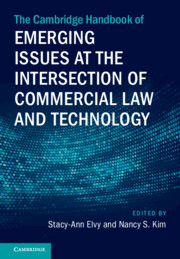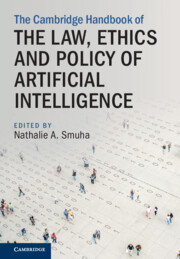Refine search
Actions for selected content:
2860 results in Computing and Society
Copyright page
-
- Book:
- The Cambridge Handbook of the Law, Ethics and Policy of Artificial Intelligence
- Published online:
- 06 February 2025
- Print publication:
- 13 February 2025, pp iv-iv
-
- Chapter
-
- You have access
- Open access
- HTML
- Export citation
4 - Fairness and Artificial Intelligence
- from Part I - AI, Ethics and Philosophy
-
-
- Book:
- The Cambridge Handbook of the Law, Ethics and Policy of Artificial Intelligence
- Published online:
- 06 February 2025
- Print publication:
- 13 February 2025, pp 79-100
-
- Chapter
-
- You have access
- Open access
- HTML
- Export citation
Contributors
-
- Book:
- The Cambridge Handbook of the Law, Ethics and Policy of Artificial Intelligence
- Published online:
- 06 February 2025
- Print publication:
- 13 February 2025, pp xiii-xxiv
-
- Chapter
-
- You have access
- Open access
- HTML
- Export citation
20 - Artificial Intelligence and Armed Conflicts
- from Part III - AI across Sectors
-
-
- Book:
- The Cambridge Handbook of the Law, Ethics and Policy of Artificial Intelligence
- Published online:
- 06 February 2025
- Print publication:
- 13 February 2025, pp 411-428
-
- Chapter
-
- You have access
- Open access
- HTML
- Export citation
Figures and Tables
-
- Book:
- The Cambridge Handbook of the Law, Ethics and Policy of Artificial Intelligence
- Published online:
- 06 February 2025
- Print publication:
- 13 February 2025, pp xi-xii
-
- Chapter
-
- You have access
- Open access
- HTML
- Export citation
19 - The Use of Algorithmic Systems by Public Administrations
- from Part III - AI across Sectors
-
-
- Book:
- The Cambridge Handbook of the Law, Ethics and Policy of Artificial Intelligence
- Published online:
- 06 February 2025
- Print publication:
- 13 February 2025, pp 383-410
-
- Chapter
-
- You have access
- Open access
- HTML
- Export citation
9 - Artificial Intelligence and Competition Law
- from Part II - AI, Law and Policy
-
-
- Book:
- The Cambridge Handbook of the Law, Ethics and Policy of Artificial Intelligence
- Published online:
- 06 February 2025
- Print publication:
- 13 February 2025, pp 174-191
-
- Chapter
-
- You have access
- Open access
- HTML
- Export citation
16 - Artificial Intelligence and Financial Services
- from Part III - AI across Sectors
-
-
- Book:
- The Cambridge Handbook of the Law, Ethics and Policy of Artificial Intelligence
- Published online:
- 06 February 2025
- Print publication:
- 13 February 2025, pp 322-338
-
- Chapter
-
- You have access
- Open access
- HTML
- Export citation
Dedication
-
- Book:
- The Cambridge Handbook of the Law, Ethics and Policy of Artificial Intelligence
- Published online:
- 06 February 2025
- Print publication:
- 13 February 2025, pp v-vi
-
- Chapter
-
- You have access
- Open access
- HTML
- Export citation
18 - Legal, Ethical, and Social Issues of AI and Law Enforcement in Europe
- from Part III - AI across Sectors
-
-
- Book:
- The Cambridge Handbook of the Law, Ethics and Policy of Artificial Intelligence
- Published online:
- 06 February 2025
- Print publication:
- 13 February 2025, pp 367-382
-
- Chapter
-
- You have access
- Open access
- HTML
- Export citation

The Cambridge Handbook of Emerging Issues at the Intersection of Commercial Law and Technology
-
- Published online:
- 08 February 2025
- Print publication:
- 20 February 2025

The Cambridge Handbook of the Law, Ethics and Policy of Artificial Intelligence
-
- Published online:
- 06 February 2025
- Print publication:
- 13 February 2025
-
- Book
-
- You have access
- Open access
- Export citation
8 - Platform Responsibility Reforms
-
-
- Book:
- Defeating Disinformation
- Published online:
- 30 January 2025
- Print publication:
- 06 February 2025, pp 122-142
-
- Chapter
-
- You have access
- Open access
- HTML
- Export citation
5 - Safe Harbor and Content Moderation Regulation in India
-
-
- Book:
- Defeating Disinformation
- Published online:
- 30 January 2025
- Print publication:
- 06 February 2025, pp 60-84
-
- Chapter
-
- You have access
- Open access
- HTML
- Export citation
11 - Policy Approaches to Defining and Enforcing Responsibilities for Online Platforms
-
-
- Book:
- Defeating Disinformation
- Published online:
- 30 January 2025
- Print publication:
- 06 February 2025, pp 180-192
-
- Chapter
-
- You have access
- Open access
- HTML
- Export citation
Contents
-
- Book:
- Defeating Disinformation
- Published online:
- 30 January 2025
- Print publication:
- 06 February 2025, pp vii-viii
-
- Chapter
-
- You have access
- Open access
- HTML
- Export citation
2 - The United States’ Approach to “Platform” Regulation
-
-
- Book:
- Defeating Disinformation
- Published online:
- 30 January 2025
- Print publication:
- 06 February 2025, pp 7-19
-
- Chapter
-
- You have access
- Open access
- HTML
- Export citation
Abbreviations
-
- Book:
- Defeating Disinformation
- Published online:
- 30 January 2025
- Print publication:
- 06 February 2025, pp xvii-xx
-
- Chapter
-
- You have access
- Open access
- HTML
- Export citation
7 - International Dimensions of Infectious Disease Control
-
-
- Book:
- Defeating Disinformation
- Published online:
- 30 January 2025
- Print publication:
- 06 February 2025, pp 105-121
-
- Chapter
-
- You have access
- Open access
- HTML
- Export citation
15 - Conclusion
-
-
- Book:
- Defeating Disinformation
- Published online:
- 30 January 2025
- Print publication:
- 06 February 2025, pp 247-256
-
- Chapter
-
- You have access
- Open access
- HTML
- Export citation
